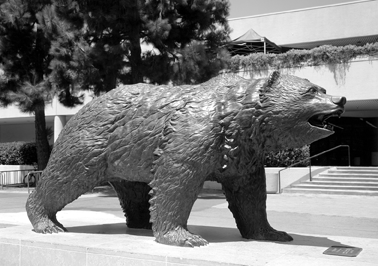
UCLA is a large urban university situated between the city and the sea at the foot of the Santa Monica Mountains. Less than six miles from the Pacific Ocean, it is bordered by Sunset and Wilshire Boulevards. As the city has grown physically and culturally, so has the campus, whose students and faculty members mirror the cultural and racial diversity of today’s Los Angeles. UCLA is one of the most widely respected and recognized universities in the world, and its impact on society can be felt into the far reaches of the globe. Students come from around the world to receive a UCLA education, and our alumni go on to become leaders in their fields, from elected officials to heads of international corporations.
UCLA is recognized as the West’s leading center for the arts, culture, and medical research. Each year, more than half a million people attend visual and performing arts programs on campus, while more than 300,000 patients from around the world come to the Ronald Reagan UCLA Medical Center for treatment. The university’s 419-acre campus houses the College of Letters and Science and 12 professional schools. There are over 45,000 students enrolled in 134 undergraduate and 258 graduate degree programs.
UCLA is rated one of the best public research universities in the U.S. and among a handful of top U.S. research universities, public and private. The chief executive of UCLA is Chancellor Gene D. Block. He oversees all aspects of the university’s three-part mission of education, research, and service.
Southern California has grown to become one of the nation’s dominant industrial centers, and the UCLA Henry Samueli School of Engineering and Applied Science is uniquely situated as a hub of engineering research and professional training for this region.
The UCLA College of Engineering (as it was known then) was established in 1943 when California Governor Earl Warren signed a bill to provide instruction in engineering at the UCLA campus. It welcomed its first students in 1945, and was dedicated as the Henry Samueli School of Engineering and Applied Science in 2000. The school ranks among the top 10 engineering schools in public universities nationwide.
UCLA engineering faculty members are active participants in many interdisciplinary research centers. The Synthetic Control Across Length-Scales for Advancing Rechargeables (SCALAR) Center is exploring new types of chemistry and materials for rechargeable batteries. The Center for Translational Applications of Nanoscale Multiferroic Systems (TANMS) strives to revolutionize development of consumer electronics by engineering materials that optimize energy efficiency, size, and power output on the small scale. The Focus Center on Function Accelerated nanoMaterial Engineering (FAME) aims to revolutionize semiconductor technologies by developing new nanoscale materials and structures that take advantage of properties unavailable at larger scales. The WIN Institute of Neurotronics (WINs) focuses on cutting-edge technology, including nanostructures. The Center of Excellence for Green Nanotechnologies undertakes frontier research and development in the areas of nanotechnology in energy and nanoelectronics. The Center for Domain-Specific Computing (CDSC) is developing high-performance, energy efficient, customizable computing that could revolutionize the way computers are used in health care and other important applications. The Smart Grid Energy Research Center (SMERC) conducts research, creates innovations, and demonstrates advanced wireless/communications, Internet, and sense-and-control technologies to enable the development of the next generation of the electric utility grid. The Wireless Health Institute (WHI) is a community of UCLA experts and innovators from a variety of disciplines dedicated to improving health care delivery through the development and application of wireless network-enabled technologies integrated with current and next-generation medical enterprise computing. The Named Data Networking (NDN) Project is investigating the future of the Internet’s architecture, capitalizing on its strengths and addressing weaknesses, to accommodate emerging patterns of communication. The NSF Center for Encrypted Functionalities (CEF) explores program obfuscation which uses new encryption methods to make a computer program, and not just its output, invisible to an outside observer, while preserving how it works — its functionality — thus enhancing cybersecurity. The B. John Garrick Institute for the Risk Sciences is committed to the advancement and application of the risk sciences to save lives, protect the environment, and improve system performance. Finally, the California NanoSystems Institute (CNSI) — a joint endeavor with UC Santa Barbara — develops the information, biomedical, and manufacturing technologies of the twenty-first century.
In addition, the school has identified critical areas for collaborative research that will have a major impact on the future of California and the world. Among these are biomedical informatics; alternative energy solutions; secure electronic transfer of information; new tools for the entertainment industry; systems, dynamics, and controls; advanced technologies for water reclamation; and new approaches and technologies for aerospace engineering.
And the school has established the Institute for Technology Advancement (ITA) dedicated to the effective transition of high-impact innovative research from UCLA to product development and commercialization.
The school offers 40 academic and professional degree programs. The Bachelor of Science degree is offered in Aerospace Engineering, Bioengineering, Chemical Engineering, Civil Engineering, Computer Engineering, Computer Science, Computer Science and Engineering, Electrical Engineering, Materials Engineering, and Mechanical Engineering. The undergraduate curricula leading to these degrees provide students with a solid foundation in engineering and applied science and prepare graduates for immediate practice of the profession as well as advanced studies. In addition to engineering courses, students complete about one year of study in the humanities, social sciences, and/or fine arts.
Master of Science and Ph.D. degrees are offered in Aerospace Engineering, Bioengineering, Chemical Engineering, Civil Engineering, Computer Science, Electrical Engineering, Manufacturing Engineering (M.S. only), Materials Science and Engineering, and Mechanical Engineering. The schoolwide online Master of Science in Engineering degree program includes 11 individual degrees. The Engineer degree is a more advanced degree than the M.S. but does not require the research effort and orientation involved in a Ph.D. dissertation. For information on the Engineer degree, see Graduate Programs on page 25. A one-year program leading to a Certificate of Specialization is offered in various fields of engineering and applied science.